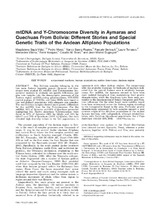mtDNA and y-chromosome diversity in aymaras and quechuas from Bolivia : different stories and special genetic traits of the andean altiplano populations

View/
Date
2011-04-05Author
Gayà-Vidal, Magdalena
Moral, Pedro
Saenz-Ruales, Nancy
Gerbault, Pascale
Tonasso, Laure
Villena, Mercedes
Vasquez, René
Bravi, Claudio M
Dugoujon, Jean-Michel
Metadata
Show full item recordAbstract
Abstract.
Two Bolivian samples belonging to the
two main Andean linguistic groups (Aymaras and Quechuas) were studied for mtDNA and Y-chromosome uniparental markers to evaluate sex-specific differences and
give new insights into the demographic processes of the
Andean region. mtDNA-coding polymorphisms, HVI-HVII
control regions, 17 Y-STRs, and three SNPs were typed in
two well-defined populations with adequate size samples.
The two Bolivian samples showed more genetic differences
for the mtDNA than for the Y-chromosome. For the
mtDNA, 81% of Aymaras and 61% of Quechuas presented
haplogroup B2. Native American Y-chromosomes were
found in 97% of Aymaras (89% hg Q1a3a and 11% hg
Q1a3*) and 78% of Quechuas (100% hg Q1a3a). Our data
revealed high diversity values in the two populations, in
agreement with other Andean studies. The comparisons
with the available literature for both sets of markers indicated that the central Andean area is relatively homogeneous. For mtDNA, the Aymaras seemed to have been
more isolated throughout time, maintaining their genetic
characteristics, while the Quechuas have been more permeable to the incorporation of female foreigners and Peruvian influences. On the other hand, male mobility would
have been widespread across the Andean region according
to the homogeneity found in the area. Particular genetic
characteristics presented by both samples support a past
common origin of the Altiplano populations in the ancient
Aymara territory, with independent, although related histories, with Peruvian (Quechuas) populations.
